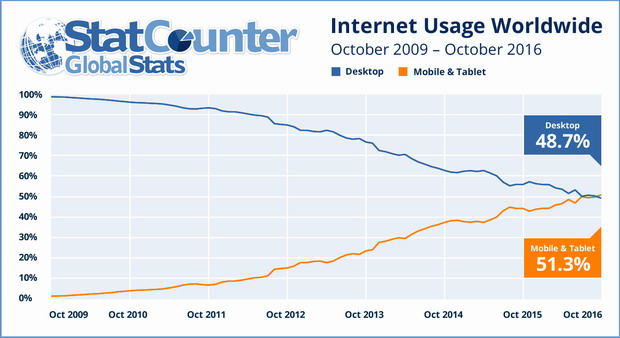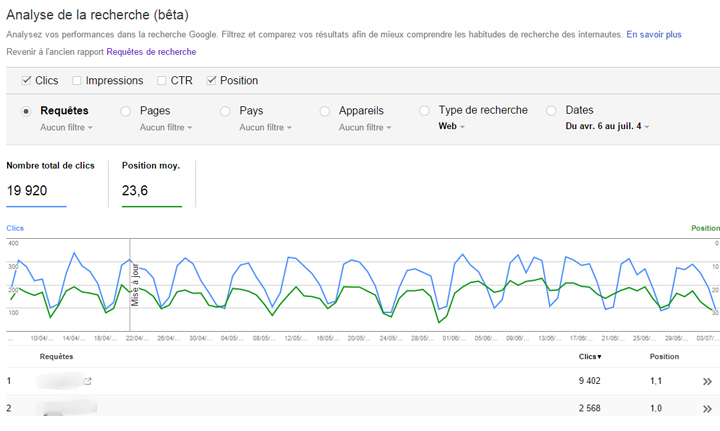Mobile First Index: adapting to the new Google search
Over the past couple of years, the SEO and search world has been talking about the biggest change to Google search results in some time.
This change is Mobile-First Indexing, resulting from Google’s desire to progressively highlight sites offering the best mobile experience.
The widespread rollout has officially begun and involves Google now prioritizing mobile sites in its search results, as announced in a statement dated March 26, 2018:
“We will continue to have only one index to determine search results. We don’t have a mobile-first index that is different from our main index. Historically, the desktop version was used for indexing; now, content from the mobile version will increasingly be used for indexing.”
Mobile First Index: what is it?
TheMobile-First Index is a change in the way Google indexes content.
Currently, when a user performs a search on Google (via desktop or mobile), the algorithm finds relevant results based on the desktop version, then ranks them and displays a snippet based on the desktop index. It then examines the signals collected by its mobile robot and adjusts the rankings accordingly.
Since the launch of the Mobile First Index, the opposite has been true. Google will first judge the mobile version of your website and from there rank the computer version.
In other words, instead of crawling the web from the perspective of a computer browser, Google will now prioritize the perspective of a mobile browser.
Mobile First Index: why?
Three years ago, Google announced that mobile searches were outpacing desktop searches.
With mobile being the predominant medium for search in 2019, it makes sense for Google to ensure that the experience on that device is as good as possible.
While content relevance is the top priority for Google, mobile versions of sites are still more neglected than desktop versions. This change is also justified by the too many cases where a user sees something in the search results, clicks on it, is redirected to the mobile home page of the site and realizes that the content they saw in their search is not available there.
So in 2019, Google wants to put an end to this bad user experience that its users commonly face.
In short, Mountain View will consider that if your content is not important enough to appear on your mobile site, then perhaps you are not the most relevant content in response to that query.
What does Google consider mobile-friendly?
Quite simply, mobile-friendly refers to any website that displays “correctly” on a mobile device. Google’s main concern is that people can :
- Quickly load all the elements of your web page;
- Read the text without having to zoom in;
- Interact with CTAs.
Mobile First Index: what impact?
This change may affect the ranking of websites that have never provided users with a good mobile experience.
If you have a responsive website and you are appropriately providing the same design, structure and content to different screen sizes and devices, then there is no reason to worry.
As for sites without a mobile version, Google specifies that it keeps the computer version for its indexing. Of course, they won’t rank as high as mobile-friendly sites, but that’s already the case.
Mobile-first: with ONLY a desktop site you’ll still be in the results & be findable. Recall how mobilegeddon didn’t send anyone to oblivion?
– Gary Illyes ᕕ( ᐛ )ᕗ (@methode) November 6, 2016
On the other hand, mobile-first indexing may impact your SEO if your mobile and desktop sites are significantly different. Basically, the pages affected will be those that have a mobile version that does not include the same content as on the computer.
@krystianszastok yes
– Gary Illyes ᕕ( ᐛ )ᕗ (@methode) November 5, 2016
Remember that the mobile version of a page will now be treated as the main one. So if a page on your mobile site has much less content than the desktop version, it could have a significant impact on your visitors’ impressions of your brand and site.
8 ways to improve your website’s mobile SEO now
1 – Perform a mobile test
First of all, take the time to check how your website looks on a mobile screen, directly from your smartphone.
Remember that each page of your site must be tested separately. It’s not enough to test your homepage and take comfort in it.
Test all your pages, as your score may differ between each one. It may take some time, but it’s better to check everything now than to realize one day that some pages are killing your SEO results.
2 – Indexing of the mobile version
Check if the mobile version of your website is correctly indexed. To do this, access Google on your smartphone and type your domain name in the search bar. If you see results, it means that everything is correct. If not, you have to solve one or two problems.
One of the reasons why your mobile site was not indexed properly may be due to different URLs for your computer and mobile website.
If this is the case, it is necessary to add a sitemap to your mobile site and tag all your URLs with canonical and alternate tags. Then submit a mobile sitemap to Google Search Console, and add it to your robots.txt file.
3 – Checking the Google Search Console
Another basic tip is to go to the Google Search Console dashboard to find out what “mobile usability issues are affecting your site”.
You will see a graph with your mobile usability status. Concerns may refer to:
- Clickable elements too close together;
- Content larger than the screen;
- Texts too small to read.
Depending on the problem, an appropriate improvement should be implemented.
4 – Accessibility and visibility of content
Look at the mobile version of your site. Is the content of the computer version visible / accessible? In 2019, you need to provide a consistent experience for users regardless of the device they access your website from.
So if you’re currently deleting or hiding content on your mobile site, think about how you can display that content on both versions.
For example, don’t put a text block with 300 words of content at the top of an e-commerce category page. Consider moving this content to the bottom of the page or partially hiding it with a “read more” button. In addition to the actual content on the page, make sure your headings (H1, etc.) are not missing.
5 – Optimize speed
The speed of your website is essential to improve usability, especially on mobile. Google already considers the speed of loading a page when ranking, and this criterion will be just as important when the Mobile-First Index takes effect.
We published an article on Google Accelerated Mobile Project that hints that Google AMP is one of the technologies to watch when it comes to mobile content. Remember: in the age of AMP (favored by Google), maintaining competitive speed is vital.
Run a speed test of your pages and check if there are any problems with the loading time of any of them. If your site doesn’t load in about three seconds, investigate the reasons for its slowness and implement improvements based on the suggestions.
6 – Optimize mobile keywords
In 2019, voice search already accounts for about 20% of all searches, so the style of queries on mobile is slightly different than on desktop.
On mobile, users express their questions in a conversational manner. In addition, they usually have more pressing goals when browsing on a smartphone.
If you want to see mobile queries that are relevant to your business, check out the report for queries, clicks and positions between mobile and desktop devices on your Google Search Console.
You can also see and compare the number of desktop and mobile impressions collected for each phrase. This report is ideal because it allows you to see the differences in organic traffic across devices and helps you discover new mobile keywords that are already bringing you traffic. Use this information for future optimizations.
7 – Improve local referencing
Because user intent has become an important factor for Google, mobile SEO is increasingly focused on local search.
This makes local SEO essential for your 2019 mobile success. The elements to be taken care of :
- Google My Business: create an accurate description of your service and products and add as many high-resolution images that match your brand identity as possible. Select specific categories, link to your website, add your social accounts and make sure all your data (phone number, hours, etc.) is up to date.
- Customer reviews: probably the strongest signal for the Google local search algorithm. For this reason, follow our tips for acquiring positive reviews and never leave a (mostly negative) review unanswered.
- Have the same name, address and phone number everywhere on the web.
- Schema Markup: Structured data adds additional elements that help you stand out, inform more from a search results page and attract attention.
Find out also how to add structured data to your website
8 – Moving penalty
Given the smaller screen space, Google no longer hesitates to penalize mobile sites with intrusive interstitials. These include:
- Pop-up windows that cover the entire mobile screen immediately after a user lands on a page.
- Pages that look like an ad and force the user to scroll down to ignore them
- Standalone interstitials that users must skip before accessing the desired content
Future updates to the Mobile-First Index are expected to be even tougher on websites that ruin the mobile experience of the site because of ads.
It is therefore important to update your sites so that these ads are less intrusive. This practice is both bad for your brand, your users and your traffic and there are many other ways to advertise without penalizing your website.
In summary, the Mobile-First Index represents a significant change in the way Google ranks websites. To make sure that you are not negatively affected, make sure that the user experience of your site is similar on mobile and desktop.
On the same topic, read our article ” optimizing your website for mobile and Google: best practices 2019″












Leave a Reply
You must be logged in to post a comment.